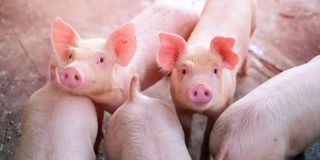The puzzle of mass deaths on a clean, organised pig farm

Pigs on a farm. Farm data collection is the most tedious part of any investigation by a vet. Yet in the data lies critical information regarding the problem at hand.
What you need to know:
There are no readily available tests for parvovirus, porcine respiratory, reproductive syndrome and African swine fever that could cause the problem
No veterinary doctor looks forward to finding themselves in the position I waded into last week.
The call sounded normal but it was clear from the onset that a farm visit was imperative.
Morgan from Nyeri county said his pigs had been dying.
Treatment by different service providers had failed to end the problem.
He wanted to know if I could provide him a solution. Morgan said in the last three months, he had lost six sows that were either pregnant, had farrowed or aborted.
The pigs showed poor appetite before stopping to eat altogether and then died.
Some showed uncoordinated movement before dropping dead.
He sent some photos of carcasses that had been opened on the farm.
The pictures indicated generalised bacterial infection with pneumonia.
They also showed an infection of the uterus called metritis. Morgan came to my office for further discussions. As we met, a call came from the public veterinary laboratory Morgan had taken a carcass to for post-mortem examination.
The doctor from the laboratory in Nyeri said the major finding was generalised bacterial infection with metritis.
However, the laboratory would follow up with culture of bacteria and test the isolated organisms to see what drugs could kill them and hence be used to treat the disease.
We agreed with Morgan that I would visit the farm to give a second opinion on the mystery.
The farm was well organised and set out for medium scale pig production.
The hygiene and cleanliness were of high standard. The farm had about 200 pigs housed in three blocks named One, Two and Three.
I changed into personal protective attire provided on Morgan’s farm.
That was an indication that the farm owner understood biosecurity.
I detailed Morgan and his team how I would carry out the investigation.
First, I reviewed the production records relating to breeding the pigs.
It is essential in providing historical information and data on the problem before and after its onset. The farm manager had kept records properly.
It was clear that the problem was confined to Block One. It started with the sows that were served in September last year.
There were 24 sows involved and six had already died. Three were sick.
Of the three, one had started farrowing in the morning but the seven foetuses that came out were dead and mummified.
I made a note to examine the sow and the dead foetuses.
Two other sows were sick and with poor or no appetite. I would check on those later.
Farm data collection is the most tedious part of any investigation.
But in the data lies a lot of information regarding the problem at hand.
I found the issues on the farm since September 2021 were return on heat after sows were served, irregular heat cycles, abortion, stillbirth, mummified foetus births and longstanding infection of the uterus.
After finishing the production data review, I inspected the farm, starting with the healthy lot in Blocks Two and Three.
The pigs were healthy, except for some with mite infestation called mange on their skin.
I advised it be treated with ivermectin injection and washing once per week with a synthetic pyrethrin preparation.
The product is good because it kills all types of skin parasites and flies.
I moved to the problematic Block One.
The two sick sows showed they had pneumonia but had normal temperature.
In most cases, pneumonia does not elevate the body temperature.
I treated them with a combination of three antibiotics to increase the range of bacteria kill of the therapy.
This was deliberate because of the report of generalised bacterial infection.
I also took blood samples from the two pigs and advised one of the antibiotics be injected daily for two more days.
The farm manager said the sow farrowing mummies was still in the process.
I cautioned it had taken too long. The breathing, temperature and heart rate of the sow were normal.
I cleaned the rear of the animal and explored the birth canal with a gloved hand.
I removed the last mummy from deep in the uterus. I also gave oxytocin to help the uterus contract and evacuate fluid.
Further, I injected a combination of three antibiotics and took a blood sample for laboratory analysis.
I confirmed most of the pigs in the block that had either aborted or given birth to mummies had infection of the uterus.
They discharged varying amounts of pus during urination.
I advised all the pigs with infection to be administered the combination antibiotics.
Mating should also be withheld for 42 days to allow for full healing, I informed Morgan and his employees.
I concluded that there was a viral infection on the farm that made it easy for bacteria to get into the sows.
I am in a dilemma because in the country, there are no readily available tests for the possible viral infections mainly parvovirus, porcine respiratory and reproductive syndrome and African swine fever that could cause the problem.
Unfortunately, two sows have since died, with one coming from the previously clean Block Two.
I have reached out to an international laboratory to see if it can help in making a definitive diagnosis to enable me device treatment and control plan.
[email protected]





